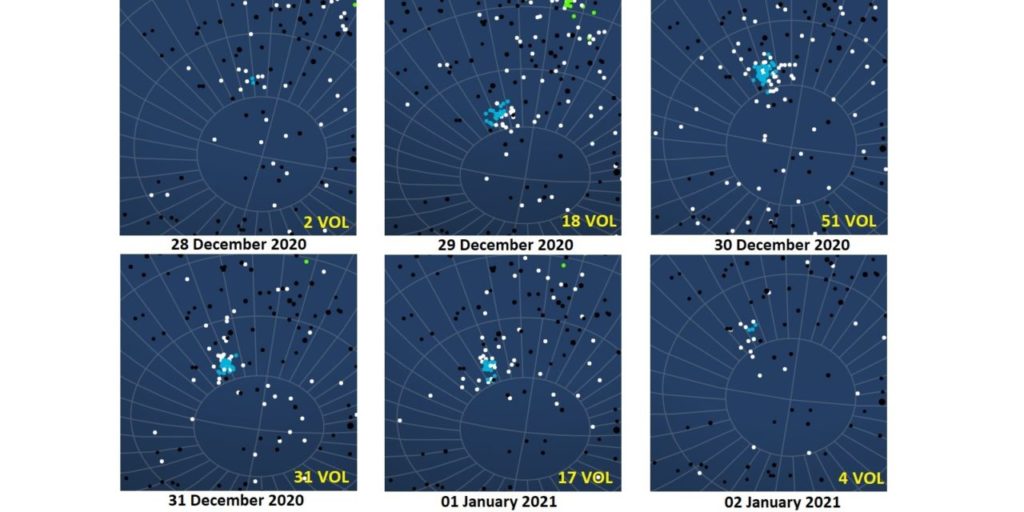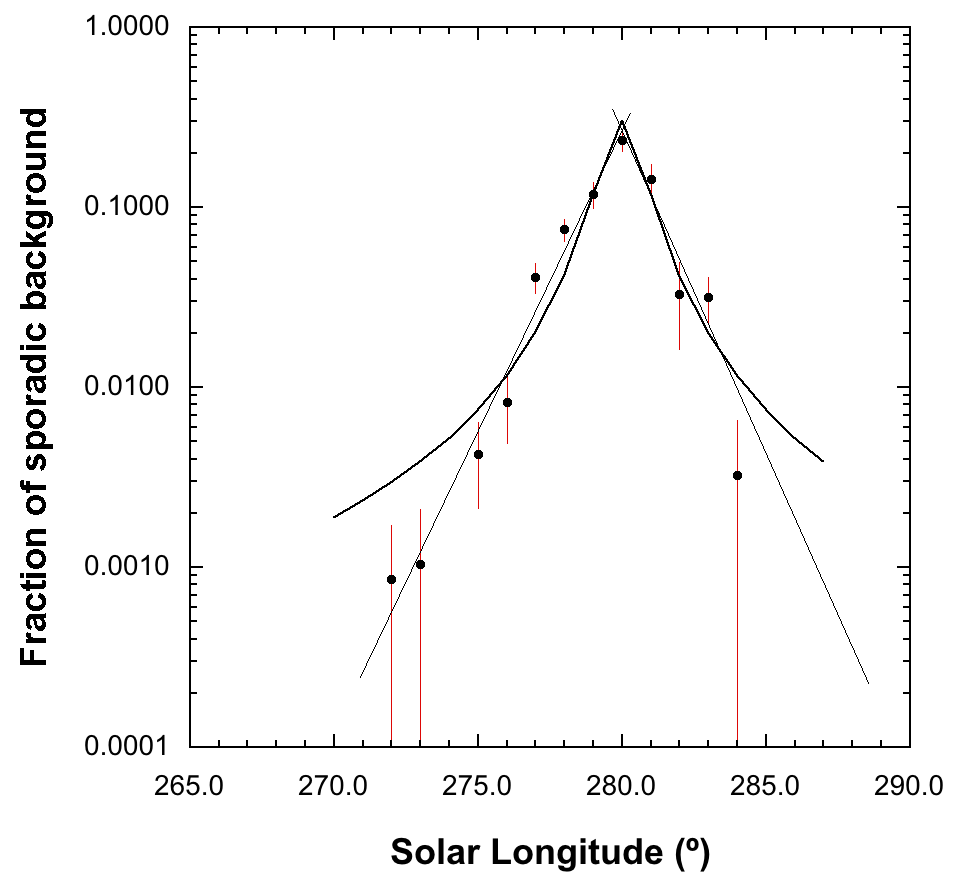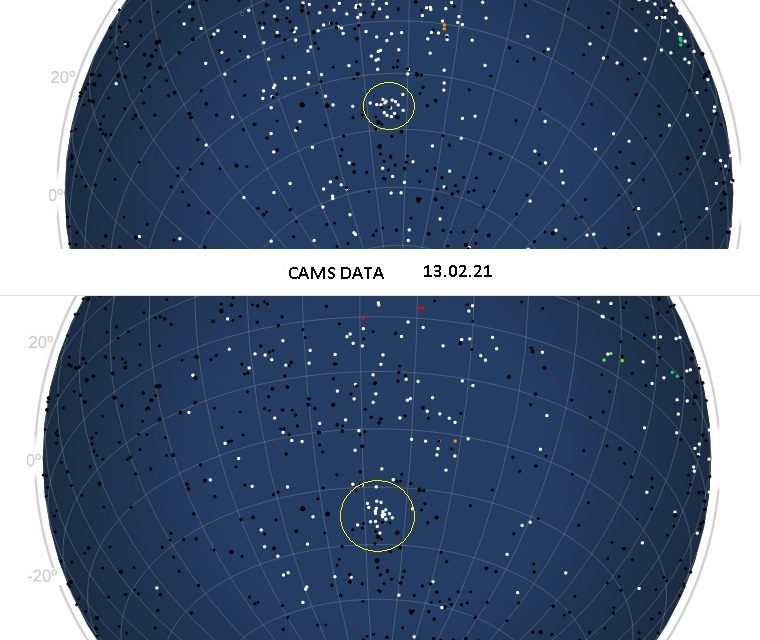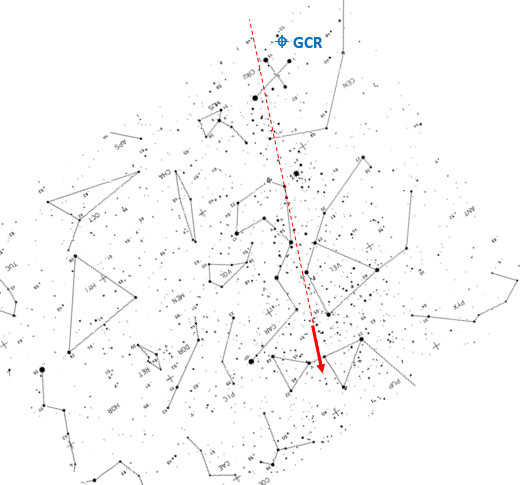At the very end of year 2020, and in mid-February 2021, two Southern minor meteor showers were detected using CAMS video network. The first one, called Volantid (VOL), peaked on December 31, 2020, confirming a previous activity enhancement recorded in 2015. The second had never been detected before, and is now confirmed as gamma-Crucid (GCR).
The return of Volantid meteor shower
The Volantid meteor shower was discovered by the CAMS (Cameras for Allsky Meteor Surveillance) video network in New Zealand during the night of 31 December 2015 (Jenniskens et al., 2016). Although both visual and video observers scanned the skies during the following years, nothing was noted from 2016 through 2019. This all changed on 28 December 2020, when several CAMS systems located in the Southern Hemisphere noted activity from this source. Activity increased and reached maximum activity near 12:00 Universal Time (UT) on 31 December 2020 (Figure 1).

The only visual data received by the IMO was by veteran observer Tim Cooper from Benoni, South Africa. He was able to view Volantid activity on two nights. On the night of 29/30 December 2020, Tim observed for 3.6 hours centered near 22:00 UT. Under poor conditions with a bright Moon, he was able to see 3 Volantids and 6 sporadic meteors. His second observation occurred on the night of 31 December 2020. During that session he observed from 18:02 to 23:12 UT, some 10 hours after maximum activity. His rates under bright moonlight were 3 Volantids and 5 sporadic meteor in 2.75 hours.

As you can see from the plot above (Figure 2), the Volantids never quite reached the rate of sporadic meteors, which is near 10 per hour as seen from the subtropical regions of the Southern Hemisphere this time of year. If the skies had been dark without interfering moonlight, perhaps 5 Volantids may have been observed per hour near midnight local standard time, when the radiant would have been placed highest in the sky. At maximum, the Volantid radiant is located at R.A. ~ 120.6° ; Dec. ~ -72°, which places it in central Volans, 2 degrees northeast of the 4th magnitude star know as zeta Volantis. The nearest bright star is 2nd magnitude Miaplacidus (beta Carinae), which lies approximately 20 degrees northeast of the Volantid radiant. Unfortunately the Volantid radiant never clears the horizon north of 18 degrees north latitude, therefore these meteors are not visible from a majority of the Northern Hemisphere.
There may be a five year periodicity with this stream so no activity may be seen until 2025. Regardless, visual observers in the Southern Hemisphere are still encouraged to check for activity from this source near the end of every year. 2021 is especially favorable as the Moon is approaching its new phase and will not interfere with observing.
Discovery of gamma-Crucids (GCR)
The second surprise display occurred on the night of 13 February 2021, when swift meteors from northeastern Crux were noticed in several CAMS systems located in the Southern Hemisphere. First alert to this display come from experienced observer Ivan Sergey, who was looking for possible radiants on the nightly charts provided on the NASA Meteor Shower Portal (Figure 3).

Figure 3- CAMS data recorded on Feb 14, 2021. Courtesy Peter Jenniskens
Several active visual observers located in the Southern Hemisphere were then alerted of this possible display. Adam Marsh, located in Queensland, Australia, was fortunate enough to be observing during this period (15 February 2021) and recorded 3 possible gamma Crucid meteors during 90 minutes of observing (10:30-12:00UT) . He mentions that the meteor were fairly bright with a medium-fast velocity near 50km/sec. Con Stoitsis, viewing from the suburbs of Melbourne, viewed from 10:45-12:30 on 17 February 2021 and did not witness any activity from the gamma Crucids. He mentioned that there was slight lunar interference during his evening session. By that date the display was most likely over. The others all experienced inclement weather. Tim Cooper did provide a plot of a possible GCR fireball, caught on video by another observer located in South Africa (Figure 4).

Figure 4- Tim Cooper plotted a fireball recorded on video by SAAO member Willie Koorts on the morning of 16 February 2021, from Cape Town, Western Cape, South Africa.
The activity period of this display is 11-16 February. The radiant at maximum lies near R.A ~ 193° ; Dec. ~ -56°. See this location printed in blue on Figure 4. This area of the sky is located on the border of Crux and Centaurus, 3 degrees northeast of the 2nd magnitude star known as Gacrux (gamma Crucis). The entry velocity is near 56 km/sec. Dr. Jenniskens states that “this meteoroid stream belongs to an unknown Halley-type comet in a steeply inclined orbit to the ecliptic plane.” (Jenniskens 2021)
Viewing circumstances in 2022 are not favorable as the full moon occurs on 16 February. Those with video camera systems located in the Southern Hemipshere are encouraged to monitor the activity period next year as video systems are less affected by lunar interference. As with the Volantids, the gamma Crucids are not well seen from the Northern Hemisphere as the radiant only clears the horizon south of latitude 34° north latitude.
References
- Jenniskens P., Baggaley J., Crumpton I., Aldous P., Gural P. S., Samuels D., Albers J., Soja R. (2016). “A surprise southern hemisphere meteor shower on New-Year’s Eve 2015: the Volantids (IAU#758, VOL)”. WGN, Journal of the International Meteor Organization, 44, 35–41.
- Jenniskens P. (2020). “Volantid meteors 2020”. CBET 4901, 2020 December 29.
- Jenniskens P. (2021a). “Return of Volantid meteor shower, expected to peak on New Year’s Eve”. eMetN, 6, 22–23.
- Jenniskens P. (2021b). “Volantid meteors 2020”. CBET 4923, 2021 January 24.
- Jenniskens P., Cooper T. “2020 Return of the Volantids VOL, IAU#758). Meteor News (https://www.meteornews.net/2021/02/02/the-2020-return-of-the-volantids-vol758/), Accessed 2021 February 15.
- Jenniskens P. (2021b). “Outburst of Gamma Crucids in 2021 GCR, IAU#1047. Meteor News (https://www.meteornews.net/2021/02/15/gamma-crucids-2021-gcr1047/), Accessed 2021 February 23.
- Marsh, Adam. Personal Communication, 2021 February 15
- Stoitsis, Con . Personal Communication, 2021 February 17
- Cooper, Tim. Personal Communication, 2021 February 19




 You saw something bright and fast? Like a huge shooting star? Report it: it may be a fireball.
You saw something bright and fast? Like a huge shooting star? Report it: it may be a fireball.  You counted meteors last night? Share your results with us!
You counted meteors last night? Share your results with us!  You took a photo of a meteor or fireball? You have a screenshot of your cam? Share it with us!
You took a photo of a meteor or fireball? You have a screenshot of your cam? Share it with us!  You caught a meteor or fireball on video? Share your video with us!
You caught a meteor or fireball on video? Share your video with us!